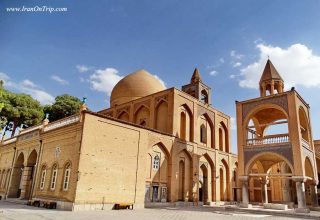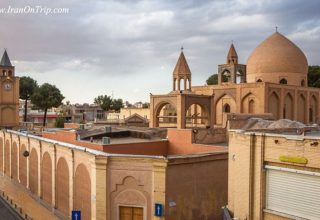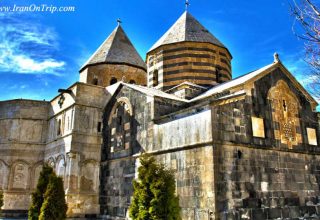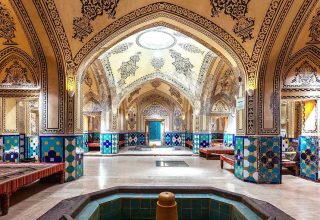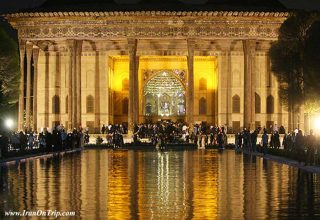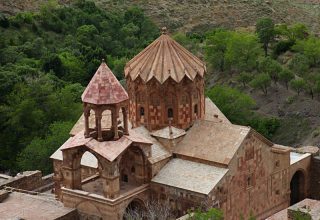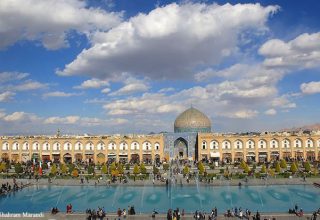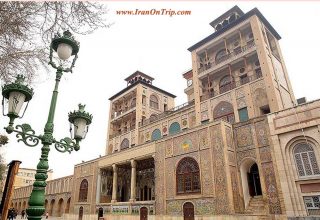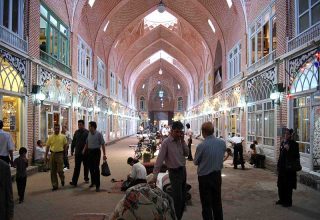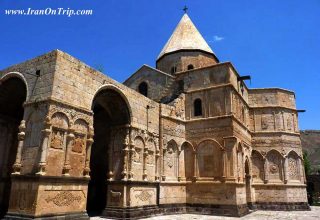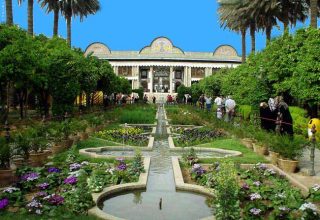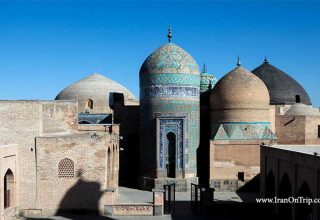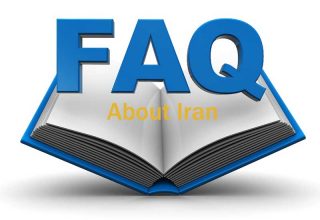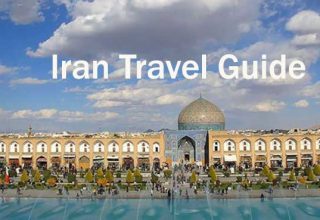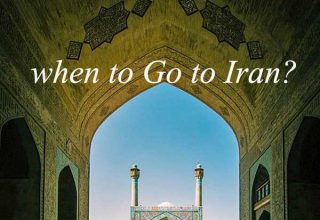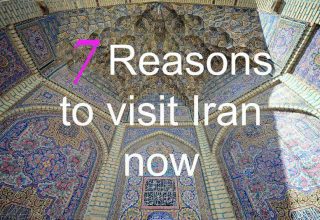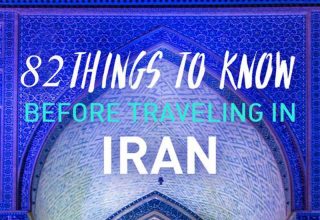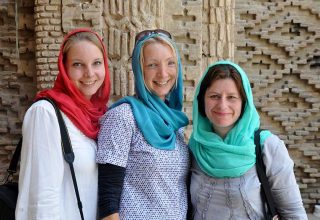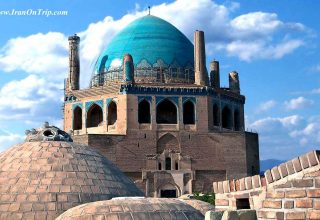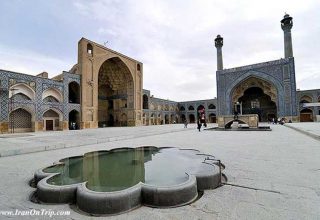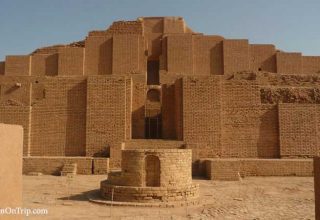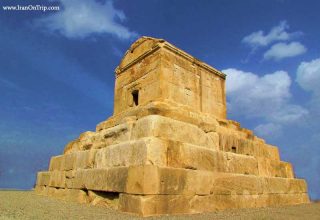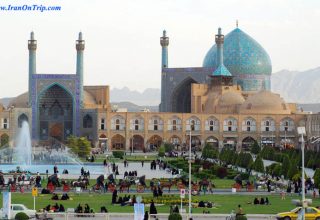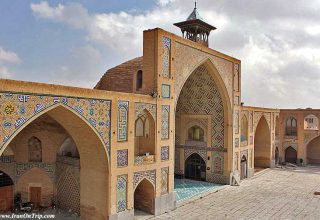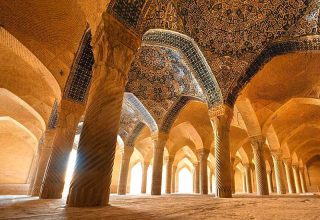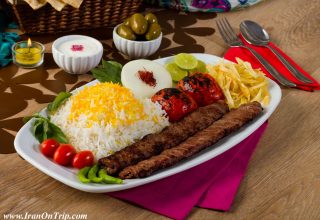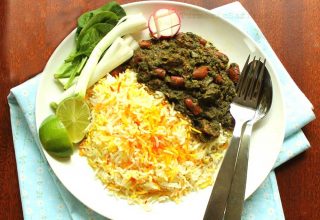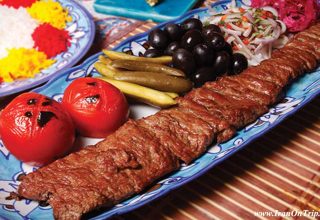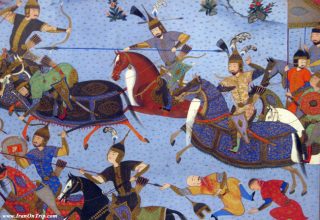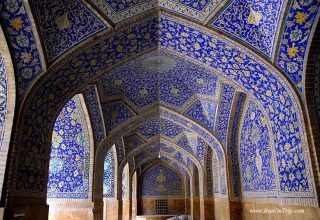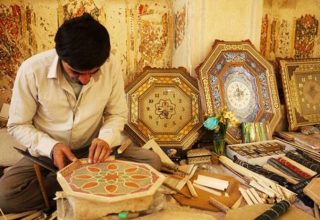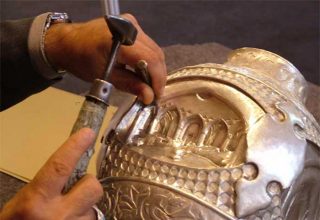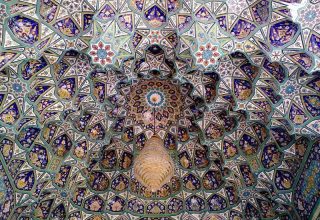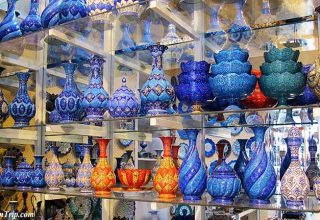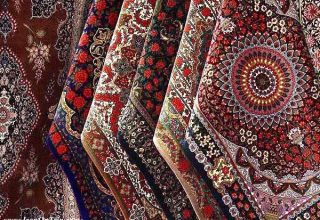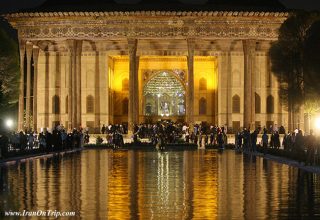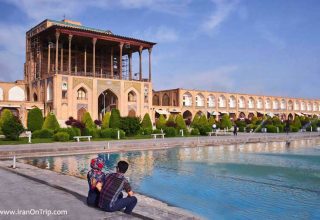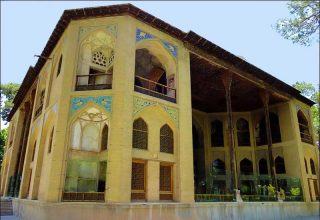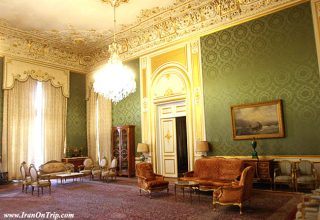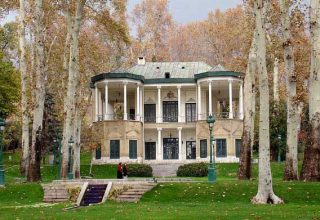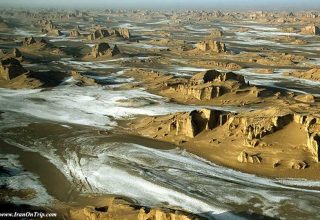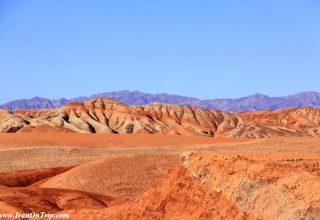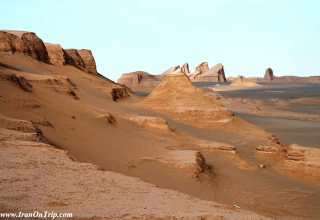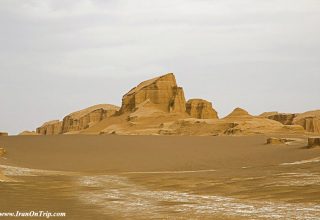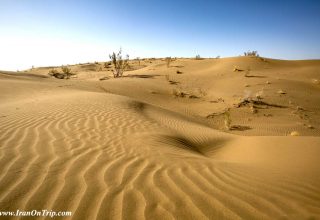
The first capital of the Iranian tribes and the Achaemenian empire, Pasargadae is situated between the present-day Marvdasht and Saadat Abad 130 km to the northeast of Shiraz, not far from Esfahan-Shiraz road and less than 50 km from Persepolis. The nearby village is called Madar-e Suleiman (The Mother of Solomon) in much the same legendary ways as Persepolis is known as Takht-e Jamshid (The Throne of Jamshid). But there is no mythology about Cyrus the Great (550-530 BC) and his son Cambyses II (530-521 BC) who created the military encampment and associated buildings that the visitor now sees, with a clear influence of the Mesopotamian ziggurat.
By starting from Shiraz early in the morning, all the separate sites can be seen with much haste in one day. Chronologically it is preferable to visit Pasargadae first, and travelers coming by road from Tehran will automatically do so. Those approaching from Shiraz, with only one day to spare, should go straight to Persepolis and photographers should make for the bas-reliefs on the east wall of the Apadana, then stop at Naqsh-e Rostam, spend the rest of the morning at Pasargadae and return to Persepolis to see Naqsh-e Rajab between 2.30 and 3 p.m. for the best light, then completing the tour of Persepolis.
Cyrus defeated his overlord and grandfather, King Astyages on this field in 550 BC and decided to make his headquarters here. There is a building here which is generally agreed that it is the tomb of Cyrus, built (546 BC) during his lifetime. This 12-m high imposing stepped tomb of Cyrus, symbolizing in its somber linearity the simplicity and greatness that made the man a potential world conqueror, dominates Pasargadae as the Builder deserves. It consists of a small chamber borne by a basement of six courses which diminish upwards, so as to form steps. The tomb is entirely built of megalithic stone.Originally the Magi, guardians of Cyruss tomb, lived within the surrounding gardens in a separate dwelling. The interior of the mausoleum was richly furnished; the embalmed body of the king lay in a golden sarcophagus on a gold couch, with a gold table by its side, on which various treasures were laid. Alexander the Great made several pilgrimages to the tomb, the last after it had been despoiled during his absence in India.
Various classical writers mention an inscription on the tomb, no trace of which remains. According to Strabo this read: “O man, I am Cyrus who founded the Empire of the Persians and was king of Asia. Grudge me therefore not this monument.”In ancient times it was surrounded by a portico, some bases of which can still be seen. The massive monolithic door of the buried chamber (now missing) could only be opened from the inside but the ingenious robbers had prized up a stone at the threshold and wriggled underneath the door. The contents of this tomb which Alexander visited were looted during the disorders which followed the latter’s departure for Bactriana and India, in spite of a permanent guard of magi, who received a sheep daily and a horse Palace on the left, and ending in the Audience Hall. Both palaces were surrounded by protective walls until 1971 and are built on the oblong plan in contrast to the later, square plan of the Persepolis palaces. Only one tapered column of the original eight stands in place in the lofty central hall of the Audience Palace, a storks nest in permanent occupation on its top. Originally double-horned lion promotes formed the capitals. Four low-ceiling porticos were also supported by columns, 48 supporting the northern colonnade.
On the doorways of Palaces bas-reliefs of partly Assyrian inspiration can be seen, while on the southeast corner a stone shaft bears a cuneiform inscription in Old Persian, Elamite and Babylonian, reading ” I Cyrus, the King, the Achaemenian” (built this). According to the latest conclusions of Mr David Stronach, Director of the British Institute of Persian Studies, who carried out his excavations from 1961 to 1963, the strangely asymmetrical plan of the Residential Palace, and the inferior quality of the western portico, can both be attributed to the fact the Cyrus never finished the monument and that Darius, whose main building interests lay elsewhere, was not interested in completing the whole of the concept. Traces have been found of red, white, and blue plaster that was apparently used to cover wooden columns in some part of the structure.
From this palace a footpath on the original Achaemenian road leads north to the remains of the so-called Zendan-e Suleiman (Solomon’s Prison), of which the Kabe Zardusht in Naqsh-e Rostam is better-preserved replica. A little to the northeast again you reach a large stone platform on a hill known as the Takht-e Madar-e Soleyman ( Throne of the Mother of Solomon), which is fitted without mortar but with metal clamps, mostly now stolen. Latest excavations have revealed imposing stone staircases on the northern side of the platform and four distinct phas
Pasargadae: UNESCO Historical Site: Pasargadae This is the capital city of the first dynastic Persian Empire, Achaemenians in ancient Iran. Pasargadae is also the first example of Achaemenians’ palace compounds and the first examples of Persian garden planning in Iranian history. The tomb of Cyrus the great is here …
Pasargadae was the first dynastic capital of the Achaemenid Empire, founded by Cyrus II the Great, in Pars, homeland of the Persians, in the 6th century BC. Its palaces, gardens and the mausoleum of Cyrus are outstanding examples of the first phase of royal Achaemenid art and architecture and exceptional testimonies of Persian civilization. Particularly noteworthy vestiges in the 160-ha site include: the Mausoleum of Cyrus II; Tall-e Takht, a fortified terrace; and a royal ensemble of gatehouse, audience hall, residential palace and gardens. Pasargadae was the capital of the first great multicultural empire in Western Asia. Spanning the Eastern Mediterranean and Egypt to the Hindus River, it is considered to be the first empire that respected the cultural diversity of its different peoples. This was reflected in Achaemenid architecture, a synthetic representation of different cultures.
Brief Synthesis
Founded in the 6th century BC in the heartland of the Persians (today the province of Fars in southwestern Iran), Pasargadae was the earliest capital of the Achaemenid (First Persian) Empire. The city was created by Cyrus the Great with contributions from the different peoples who comprised the first great multicultural empire in Western Asia. The archaeological remains of its palaces and garden layout as well as the tomb of Cyrus constitute an outstanding example of the first phase of the evolution of royal Achaemenid art and architecture, and an exceptional testimony to the Achaemenid civilisation in Persia. The “Four Gardens” type of royal ensemble, which was created in Pasargadae, became a prototype for Western Asian architecture and design.
The 160-ha archaeological site of Pasargadae presents some of the earliest manifestations of Persian art and architecture. It includes, among other monuments, the compact limestone tomb on the Morgab plain that once held Cyrus the Great’s gilded sarcophagus; Tall-e Takht (“Solomon’s Throne”), a great fortified platform built on a hill and later incorporated into a sprawling citadel with substantial mud-brick defences; and the royal ensemble, which consists of several palaces originally located within a garden layout (the so-called “Four Gardens”). Pasargadae became a prototype for the Persian Garden concept of four quadrants formally divided by waterways or pathways, its architecture characterised by refined details and slender verticality.
Pasargadae stands as an exceptional witness to the Achaemenid civilisation. The vast Achaemenid Empire, which extended from the eastern Mediterranean and Egypt to the Hindus River in India, is considered the first empire to be characterised by a respect for the cultural diversity of its peoples. This respect was reflected in the royal Achaemenid architecture, which became a synthesized representation of the empire’s different cultures. Pasargadae represents the first phase of this development into a specifically Persian architecture which later found its full expression in the city of Persepolis.Criterion (i):Pasargadae is the first outstanding expression of the royal Achaemenid architecture.Criterion (ii):The dynastic capital of Pasargadae was built by Cyrus the Great with a contribution by different peoples of the empire created by him. It became a fundamental phase in the evolution of the classic Persian art and architecture.Criterion (iii):The archaeological site of Pasargadae, with its palaces, gardens, and the tomb of the founder of the dynasty, Cyrus the Great, represents an exceptional testimony to the Achaemenid civilisation in Persia.Criterion (iv):The “Four Gardens” type of royal ensemble which was created in Pasargadae, became a prototype for Western Asian architecture and design.
Integrity
Within the boundaries of the archaeological site of Pasargadae are located the known elements and components necessary to express the Outstanding Universal Value of the property, including the tomb of Cyrus the Great, the remains of the Tall-e Takht fortified platform, and the remains of the royal ensemble within the Four Gardens. The ancient capital extended much beyond the inscribed property, but has not yet been excavated.
The main identified pressures on the integrity of the property are from agriculture, and from the possibility of the growth of the villages in the buffer zone. There is also a risk of flooding, which has caused some damage in past years. The violent winds and burning sun of the Morgab plain likewise represent significant threats to some of the archaeological remains. Human interventions also pose threats: damage from vandalism has been noted, and the mud-brick elements of Tall-e Takht are in poor condition because of the excavations carried out there in the 1960s.
Authenticity
There is no doubt that Pasargadae represents the ancient capital of the Achaemenians, and is authentic in terms of its location and setting, materials and substance, and forms and design. The setting of Pasargadae has undergone no change over the course of time, and the site is part of an agricultural landscape that continues to be cultivated. Recent restoration work has respected the authenticity of the monuments, utilizing traditional technology and materials in harmony with the ensemble. No changes have been made to the general plan of Pasargadae, its buildings or its gardens. Moreover, there are no modern reconstructions at Pasargadae; the remains of all the monuments are authentic.
Protection and management requirements
The Pasargadae Ensemble was registered in the national list of Iranian monuments as item no. 19 on the 24th of the month Shahrivar, 1310 SAH (15 September 1931). Relevant national laws and regulations concerning the property include the National Heritage Protection Law (1930, updated 1998) and the 1980 Legal bill on preventing clandestine diggings and illegal excavations. The inscribed World Heritage property, which is owned by the Government of Iran, and its buffer zone are under the legal protection and management of the Iranian Cultural Heritage, Handicrafts and Tourism Organization (which is administered and funded by the Government of Iran). The property and buffer zone are also under a regional master plan with its own regulations. The Pasargadae Management Plan was prepared in 2002 to provide guidance on preserving the value and significance of the archaeological and cultural landscape of this site. Pasargadae Research Base, a management and conservation office established in Pasargadae in 2001, is responsible for the investigation, conservation, restoration, reorganization, and presentation of Pasargadae. Upgrading training and skills is offered by the office in cooperation with universities and scientific institutes in Iran and abroad. Financial resources for Pasargadae are provided through national and provincial budgets, and site admission fees Sustaining the Outstanding Universal Value of the property over time will require examining, developing, and implementing methods for controlling erosion resulting from various factors (physical, chemical, environmental, etc.); minimising or eliminating any damage that may result from agriculture or from flooding; avoiding excavations that put the archaeological remains at increased risk; preventing damage caused by vandalism by training the guards and raising the awareness of local people; and preventing any improper expansion of the inhabited areas (villages, for instance) that may have a negative impact on the Outstanding Universal Value, integrity or authenticity of the property.
Long Description
The dynastic capital of Pasargadae was built by Cyrus the Great in the 6th century BC with contributions from different peoples of the empire created by him. It became a fundamental phase in the evolution of the classic Persian art and architecture. With its palaces, gardens, and the tomb of the founder of the dynasty, Cyrus the Great, Pasargadae represents exceptional testimony to the Achaemenid civilisation in Persia. The ‘Four Gardens’ type of royal ensemble created in Pasargadae became a prototype for Western Asian architecture and design.
Pasargadae is located in the plain on the river Polvar, in the heart of Pars, the homeland of the Persians. The position of the town is also denoted in its name: ‘the camp of Persia’. The core zone of the site is surrounded by a large landscape buffer zone. The core area contains many monuments: the Mausoleum of Cyrus the Great is built from white limestone around 540-530 BCE. The mausoleum chamber, on the top, has the form of a simple gable house with a small opening from the west. In the medieval period, the monument was thought to be the tomb of Solomon’s mother, and a mosque was built around it, using columns from the remains of the ancient palaces. A small prayer niche (mihrab ) was carved in the tomb chamber. In the 1970s, during a restoration, the remains of the mosque were removed, and the ancient fragments were deposited close to their original location.The Tall-e Takht refers to the great fortified terrace platform built on a hill at the northern limit of Pasargadae. This limestone structure is built from dry masonry, using large regular stone blocks and a jointing technique called anathyrosis, which was known in Asia Minor in the 6th century. The first phase of the construction was built by Cyrus the Great, halted at his death in 530 BCE. The second phase was built under Darius the Great (522-486 BCE), using mud brick construction.The royal ensemble occupies the central area of Pasargadae. It consists of several palaces originally located within a garden ensemble (the so-called ‘Four Gardens’). The colour scheme of the architecture is given by the black and white stones used in its structure. The main body of the palaces is formed of a hypostyle hall, to which are attached porticoes. The Audience Hall was built around 539 BCE. Its hypostyle hall has two rows of four columns. The column bases are in black stone and the column shafts in white limestone. The capitals were in black stone. There is evidence of a capital representing a hybrid, horned and crested lion. The palace had a portico on each side. Some of the bas-reliefs of the doorways are preserved, showing human figures and monsters.The Residential Palace of Cyrus II was built 535-530 BCE; its hypostyle hall has five rows of six columns. The Gate House stands at the eastern limit of the core zone. It is a hypostyle hall with a rectangular plan. In one of the door jambs is the famous relief of the ‘winged figure’.In later periods, Tall-e Takht continued to be used as a fort, whereas the palaces were abandoned and the material was reused. From the 7th century onwards, the tomb of Cyrus was called the Tomb of the Mother of Solomon, and it became a place of pilgrimage. In the 10th century, a small mosque was built around it, which was in use until the 14th century.
Source: UNESCO/CLT/WHC
Historical Description
[in French only]
La terre de Fars, ou Perse, était la patrie des Achéménides, la tribu perse que Cyrus II le Grand (qui régna de 559 à 529 avant notre ère environ) conduisit à la victoire sur les Mèdes en 550. Comme c’était la coutume, Cyrus choisit l’emplacement de sa capitale à proximité du site de sa victoire sur Astyage, le roi mède. Cette première victoire fut suivie par la conquête de la Lydie, de l’Empire néobabylonien et de l’Égypte, et l’empire fut ensuite consolidé et agrandi par son fils Cambyse (529-522 avant notre ère) et par Darius Ier le Grand (521-486 avant notre ère). Cyrus est évoqué dans la Bible comme le libérateur de Babylone, et celui qui ramena les Juifs de leur exil.Darius Ier décida de construire une nouvelle capitale symbolique pour l’empire, à Persépolis, quelque 70 km plus au sud. Néanmoins, Pasargades demeura un important centre dynastique jusqu’à la conquête de l’empire par Alexandre le Grand de Macédoine, en 330 avant notre ère. Selon certains auteurs antiques, comme Hérodote et Arrien, Alexandre rendit hommage à la tombe de Cyrus et la fit restaurer.Plus tard, Tall-e Takht continua d’être utilisé en tant que fort, tandis que les palais étaient abandonnés et les matériaux réutilisés. À partir du VIIe siècle, la tombe de Cyrus fut appelée la tombe de la mère de Salomon, et elle devint un lieu de pèlerinage. Au Xe siècle, une petite mosquée fut construite autour, utilisée jusqu’au XIVe siècle. Des voyageurs visitèrent le site au fil des siècles, lesquels témoignèrent de la perte progressive de divers éléments. On accordait une attention toute spéciale à la tombe de Cyrus et à la terrasse fortifiée de Tall-e Takht.
Source: Advisory Body Evaluation


